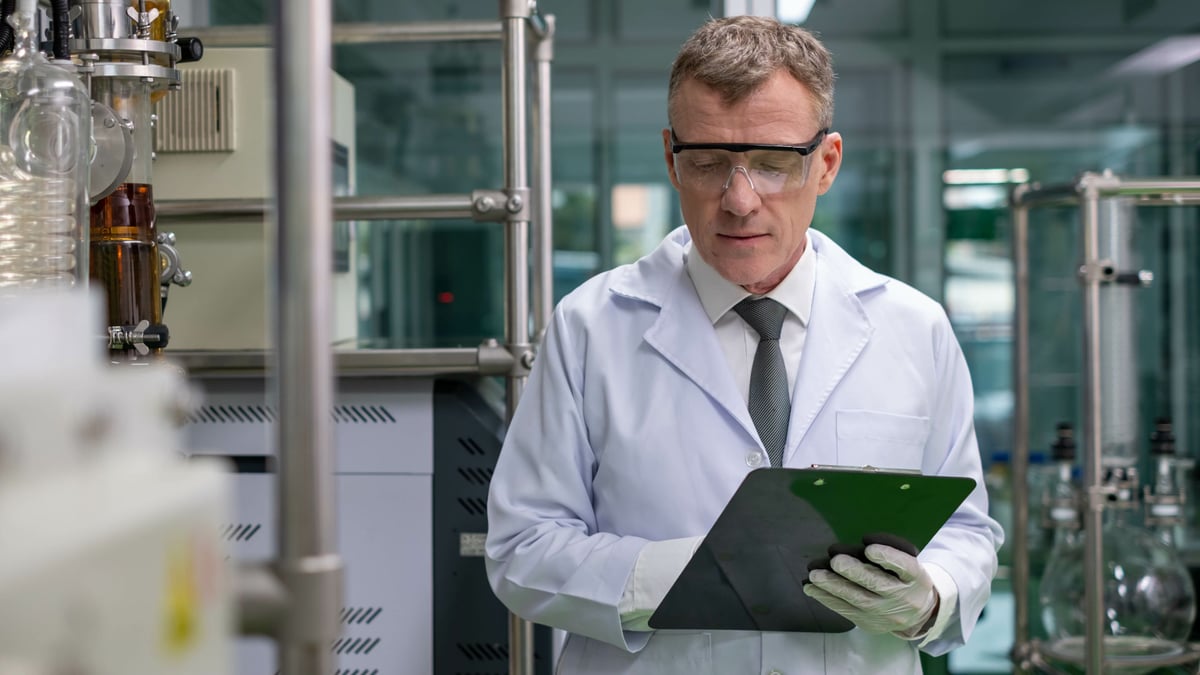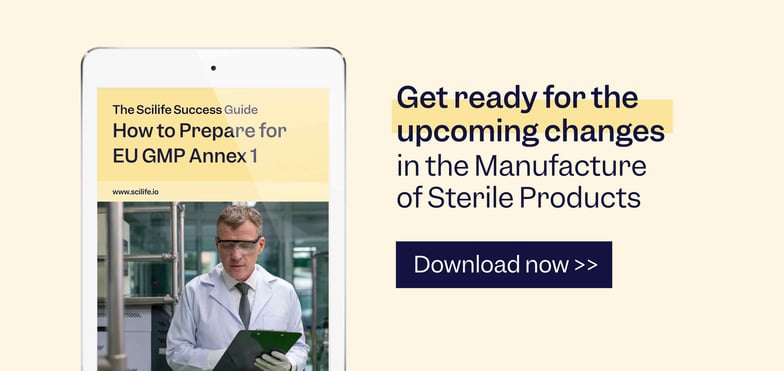
It is now well known by the Life Sciences community that the new version of EU GMP Annex 1, which was issued on 22nd August 2022, will come into force on 25 August 2023 (with the exception of chapter 8.123 "Product transfer/loading/unloading areas for lyophilizers", which will be applicable on 25 August 2024).
This new version of Annex 1 represents a significant opportunity for pharmaceutical companies to adopt advanced technologies and streamline their processes, reducing the risk of human error and ensuring that final products are safe and free from microbial, particulate, and pyrogenic contamination.
The new Annex 1 has expanded with new content and significant changes that may impact your organization on the manufacture of sterile medicinal products. It is 59 pages long compared to the previous version, which was 18 pages, introducing several new requirements and clarifying some aspects that were not adequately defined in the previous version.
The purpose of this article is to highlight the main changes with a very high-level overview, so you can identify the main gaps and take action before the new Annex 1 becomes effective.
Introduction to the main changes
Despite the unchanged goal of establishing requirements to reduce the likelihood of contamination in sterile products, there are three main focuses in the new Annex I:
The potential application of the concepts outlined in Annex 1 to non-sterile product areas.Introduction of Quality Risk Manager (QRM) and Pharmaceutical Quality System (PQS) principles.
The implementation of the Contamination Control Strategy (CCS) and a continuous monitoring approach.
The new Annex 1 places a stronger emphasis on thorough oversight and control of sterile product areas through a Contamination Control Strategy (CCS). The CCS is presented as a mandatory document, which should define all critical control points, measures, and assessment of effectiveness to control all the risks associated with product contamination.
The facility, personnel, processes, and monitoring should be assessed by the quality risk management process to identify and control risks.
It not only considers the current state of control as a main goal but also underlines the need for using advanced technologies, such as RABS and isolators.
We will go over the most interesting topics and changes.
Premises
Cleanrooms/Areas & Barrier Technologies
Annex 1 recommends using new advanced technologies to prevent contamination from materials or personnel shredding in grade A areas.
Grade A is now considered a critical zone for high-risk operations, whereas grades B, C, and D are considered cleanrooms. This classification is achieved by using unidirectional airflow within Restricted Access Barrier Systems (RABS) or isolators.
The access of personnel into the grade A area is limited through the design of facilities, equipment, processes, and procedures.
Entry of personnel
Personnel that ingress the areas should flow in one direction: from lower to higher grade areas. That is, from areas of increasing cleanliness. However, the new Annex does not state what the flow should be for people who leave the areas.
Entry of materials
The movement of materials from lower-grade cleanrooms to higher-grade areas should be subject to cleaning and disinfection, depending on the risk and the CCS.
Airflows visualization
Airflow patterns and complex gas flows within cleanrooms and zones should be visualized to demonstrate that air does not ingress from lower grade (higher contaminated) to higher grade (lower contaminated).
Cleanroom and clean air equipment qualification
Cleanrooms and clean air equipment must be classified and qualified.
For the first time, the new Annex 1 includes a list of tests to perform in the qualification: filter system, airflow, air pressure, microbial contamination, temperature, humidity, recovery, and containment leak.
The new Annex 1 specifies that the microbial concentration level must be determined during qualification. There are two changes in the maximum permitted microbial contamination levels appearing in the new annex:
-
- The average calculation of results is not considered in the table.
- No growth of microbial contamination should be seen for grade A cleanrooms.
The annex specifies for the first time the frequency or maximum time interval for qualification:
-
- 6 months for grade A/B areas
- 12 months for grade C/D areas
- 6 months for grade A/B areas
Cleanroom monitoring
The new Annex 1 places a lot of focus on continuous cleanroom monitoring and environmental monitoring as the best way to reduce contamination risk.
Cleanroom monitoring should be based on sound scientific reasoning.
It is not enough to qualify or validate facilities, equipment, and processes. Continuous verification and regular reviews must be conducted.
Disinfection
There is a stronger focus on cleaning and disinfection protocols.
Cleaning, which takes place before disinfection must not leave residues, as these may interfere with disinfectants. A sporicidal agent must also be included within the disinfection plan, across all grades of cleanrooms.
Recommended course:
Unlock the essentials of sterile manufacturing with Sterile Product Manufacturing and Aseptic Processing!
Master aseptic processing, contamination control, and more are included in our new certification.
Equipment
The new Annex 1 has expanded some points to provide general guidance on the design and operation of equipment:
- The initial qualification should incorporate a detailed description of equipment and services, and be kept up to date as part of the continuous review of the CCS.
- Process and equipment alarms should be evaluated for trends.
- Direct and indirect product contact parts with sterilized critical components should also be sterilized.
- Particle counters and their sampling tubing should be qualified.
Utilities
The previous Annex 1 did not go into much detail with utility systems - gas, water, and vacuum. The new Annex 1 incorporates new requirements:
- The criticality of each utility system needs to be assessed as part of the CCS and covered by a risk assessment. Results of critical parameters and critical quality attributes (CQA) of high-risk utilities need to be trended regularly to ensure the system’s suitability.
- Pipes and ducts are to be avoided in cleanrooms. to minimize their impact on the cleanliness and contamination control of the environment.
- Cleanrooms need to be designed with minimal air-borne and surface contamination.
Water systems
The requirements focus on actions that prevent microbiological contamination, particulate matter, and endotoxins/pyrogens. For example:
-
- Water for injections (WFI) - free from microorganisms, particulates, and endotoxins - should comply with the current monograph of the European Pharmacopoeia.
- Water should be in constant circulation at a temperature above 70ºC.
- Legs in pipelines should be avoided, if possible.
- The risk of microbial adhesion and biofilm formation in the pipes is another challenge. It can be minimized if the water flow is turbulent, and sterilization, disinfection, or regeneration of water systems is planned.
- Continuous TOC and conductivity monitoring must be in place in WFI systems.
Values exceeding the alert levels should be documented and trended. The root cause and impact on the quality of products or processes should be determined.
Steam used as a direct sterilizing agent
A regular sampling plan must be in place to ensure representative samples of pure steam are tested for analysis in which additionally non-condensable gasses, dryness value and superheat must be analyzed.
Gasses and vacuum systems
Gasses that come into direct product contact must be of the appropriate chemical, particulate and microbial quality, including oil and water content.
The gas and vacuum system should prevent backflow to avoid potential risks of contamination.
Gasses used in the aseptic processes should be filtrated by a sterilizing grade filter with a pore size of a maximum of 0.22 microns.
Heating and cooling and hydraulic systems
Special care is needed to control the risk of spillage and cross-contamination with heating, cooling, and hydraulic systems. These systems should be placed outside the filling room.
Personnel
The new Annex 1 maintains the basic requirement of having trained, qualified, and experienced personnel with a focus on sterile product protection. Personnel qualification procedures and a disqualification system must be in place.
Particular importance is given to training on hygiene, microbiology, cleanroom practices, contamination control, aseptic techniques, behaviors, gowning, and protection measures.
Production and specific technologies
The CCS should identify the risks of contamination in different areas and cleanrooms.
Several actions are suggested to control the risks. For example filtration steps to reduce bioburden prior to the filling process, and the cleaning of primary packaging containers and components.
The new Annex 1 encourages using RABS, isolators, and robotics to reduce the risk of contamination and the need for human interventions.
Human interventions
Human interventions increase the risk of introducing contamination into the aseptic filling area. Therefore, the new Annex 1 requires that human interventions are carefully designed, evaluated via risk assessment, and qualified.
Sterilization
The new Annex includes a large section on sterilization technologies.
Some principles are essential:
-
- Use scientific principles in the selection of the sterilization procedure.
- Validate the sterilization process.
- Heat sterilization is the preferred system whenever possible.
- Ethylene oxide should only be used when no other method is practicable, because of the difficulty to ensure that no residues or reaction products are controlled at acceptable limits.
- Review and verify the sterilization process at scheduled intervals according to risk assessment and CCS.
- Deviations should be investigated.
- Sterilization records should be reviewed and approved for batch release purposes.
Environmental and process monitoring
Environmental and process monitoring is an important verification tool in the CCS to ensure the air cleanliness of cleanrooms and equipment and detect deviations from established acceptance criteria.
Environmental monitoring consists of performing:
- Particle monitoring
- Viable particle monitoring
- Temperature monitoring
- Relative humidity monitoring
- Aseptic process simulation (APS) or media fill
The use of rapid monitoring methods is also recommended, to speed the early detection of microbial contamination.
The Aseptic Process Simulation (APS) or media fill is described. The information obtained is used to assess the potential for product units to become contaminated during the aseptic processing operations.
The Annex emphasizes that all routine monitoring data obtained in production should be trended and used as part of the routine batch release and periodic assessments.
Quality control
The QC part of the annex includes the requirements on
- QC/QA personnel training and experience
- Specifications
- Types of microbiological tests: bioburden, sterility etc
- Sampling
- Method verification/validation
- Parametric release
- Data review
Final considerations
In conclusion, it is important to recognize that the Annex only sets out the minimum requirements for the manufacturing of sterile medicinal products. Pharmaceutical manufacturers should continually focus on preventative strategies, including proactive risk assessments and controlled changes, supported by trending, investigations, corrective and preventive actions (CAPA), root cause determination, and the use of robust investigational tools. Producing sterile medicinal products is all about continuous improvements.
Discover how a tailored Smart QMS for Pharmaceutical companies can help you get ready for all the changes in the EU GMP Annex 1!








